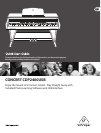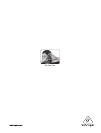
4 5CONCERT CDP2400USB Quick Start Guide
CONCERT CDP2400USB Controls
(EN) Controls
(2) (4) (5) (6) (8) (10) (15) (17)
(16) (18)
(12)
(1) (3) (7) (9) (11) (13)
(14)
(26) (27) (28)
(29)
POWER
(30)
For more details on the full functionality of this product, see the product
page on behringer.com and download the full manual.
(1) VOLUME: is used to adjust the volume of the built-in loudspeakers and headphone outputs.
(2) COLOR: Varies the sound character from soft (left) to bright (right).
(3) SPEAKERS OFF: Switches the built-in loudspeakers on and o. The MUTE LED lights up only
when the built-in loudspeakers are switched o.
(4) DEMO: Enables/disables DEMO mode.
(5) CLICK: Is used to start/stop the metronome click.
(6) TRACK 1: Selects track 1 for playback or recording. The REC LED lights up when the track
has been activated for recording. The PLAY LED lights up when the track has been set for
playback and already contains musical data.
(7) TRACK 2: Selects track 2 for playback or recording. The REC LED lights up when the track
has been activated for recording. The PLAY LED lights up when the track has been set for
playback and already contains musical data.
(8) Is used to start/stop playback or recording of the music sequencer.
(9) REC: Activates record mode.
(10) MODE: Selects the TEMPO parameter and menu pages for EDIT mode. The EDIT MODE LED
shows in EDIT mode, the TEMPO LED in TEMPO mode.
(11) Down/Up: Depending on which mode you have selected with the MODE button, these two
buttons can be used to enter the tempo or to scroll through the EDIT mode menu pages.
(12) Display: Depending on the function used, the display reads the tempo, menu numbers or
parameter values.
(13) -/NO, +/YES: Is used to raise/lower the parameter values shown in the display.
Additionally, the +/YES button executes certain EDIT functions.
(14) TONE: These 14 buttons are used for sound selection. In DEMO mode they are used to select
individual sound colordemos.
(15) REVERB: Selects one of four room eects (CHAMBER, CONCERT, CHURCH, THEATER)
for the selected sound. An LED shows which eect is currently active. If no LED lights up,
no room eect is active.
(16) SPECIAL: Is used to select one of four modulation eects (CHORUS, FLANGER,
TREMOLO, DELAY) for the selected sound. An LED shows which eect is currently
active. If no LED lights up, no modulation eect is active.
(17) KEYS: Is used to set the key velocity to SOFT, MEDIUM or HARD. An LED shows which setting
is currently active. If no LED lights up, no key velocity has been selected and playing a key
always triggers a xed volume level, irrespective of how hard you play the key.
(18) TRANSPOSE: Is used for setting keyboard/pitch transposition.
(19) MIC IN: Connect a dynamic or condenser microphone to this input using a standard
XLR cable. The jack automatically supplies 15V of phantom power. Adjust the input
sensitivity with the adjacent GAIN control.
(20) AUX IN: Connect external sound sources such as a CD or MP3 player using a ⁄" plug.
(21) LINE IN: Connect external sound sources such as CD players, mixers or drum machines
using RCA cables.
(22) LINE OUT: Connect the CDP2400USB to an external sound system or recording device
using RCA cables.
(23) PEDALS: Connect the foot pedals of the CDP2400USB to this jack using the included
5-pin cable.
(24) MIDI: Connect external devices such as synthesizers, sequencers, etc. to the CDP2400USB’s
using 5-pin DIN cables (MIDI cables). MIDI IN receives data that controls the CDP2400USB’s
internal sound generator. MIDI OUT sends controlling data from the CDP2400USB’s keys
and pedals to other MIDI devices.MIDI THRU transmits data from the MIDI IN jack to other
MIDI devices without altering the data.
(25) USB: Connect the CDP2400USB to a computer using a type B USB connector.
This connection will transmit both the audio from the internal sound generator as well
as MIDI data. You may use this to record performances or control software on your
computer via MIDI.
(26) Soft/Piano pedal: Use this to reduce the volume of a particular passage.
(27) Sostenuto pedal: This pedal sustains notes that allow distinct advantages:
•
Play a note or chord on the keys
•
While holding the note(s), press the sostenuto pedal
•
Notes played before the pedal was pressed will continue to sustain, while those played
after the pedal was pressed decay normally
(28) Damper/Forte pedal: All notes sustain when the damper/forte pedal is pressed,
even if you release the key(s).
(29) Power: Press this button to turn the CDP2400USB on and o.
(30) HEADPHONE JACKS.








